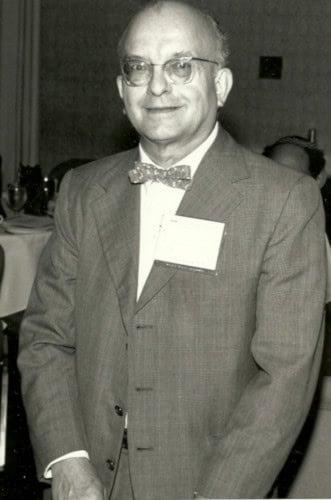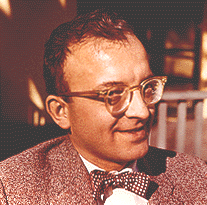
ASIS Conference 1987
©Unknown author / public domain
Calvin Mooers
Calvin Northrup Mooers (1919-1994) was an American computer scientist who was an influential figure in the early information science community. Mooers coined the term information retrieval in 1950, also called Mooers’s law in 1959, which states: An information retrieval system will tend not to be used whenever it is more painful and troublesome for a customer to have information than for him not to have it.
Mooers Found That People Avoided Information
Before he began to formulate his law, Mooers found that humans would often deliberately avoid information:
In the building and planning of our information handling and retrieving systems, we have tended to believe implicitly, and to make the assumption, that having information easily available is always a good thing, and that all people with access to an information system would want to use the system to get the information. It is now my suggestion that many people may not want information, and they will avoid using a system precisely because it gives them information.
Having information is painful and troublesome. We all have experienced this. If you have information, you must first read it, which is not always easy. You must then try to understand it. To do this, you may have to think about it. The information may require you to make decisions about it or other information. The decisions may require action in the way of a troublesome program of work, or trips or painful interviews. Understanding the information may show that your work was wrong, or that your boss was wrong, or may show that your work was needless. Having information, you must be careful not to lose it. If nothing else, information piles up on your desk—unread. It is a nuisance to have it come to you. It is uncomfortable to have to do anything about it. Finally, if you do try to use the information properly, you may be accused of puttering instead of working. Then in the end, the incorporation of the information into the work you do may often not be noticed or appreciated. Work saved is seldom recognized. Work done—even in duplication—is well paid and rewarded.
Thus not having and not using information can often lead to less trouble and pain than having and using it. Let me explain this further. In many work environments, the penalties for not being diligent in the finding and use of information are minor, if they exist at all. In fact, such lack of diligence tends often to be rewarded. The man who does not fuss with information is seen at his bench, plainly at work, getting the job done. Approval goes to projects where things are happening.
People usually take the path of least resistance. It’s easier to continue doing things the same way, as you have always done them, without reaching out to learn some new process or information that might invalidate, challenge, and force you to reassess your previous assumptions. Information can be threatening and hard to deal with. It can be thick to interpret, exhausting to follow, and painful in the realizations it provides.
People resist reading an application’s help file for all these reasons — it’s tedious, sometimes hard to understand, requires interpretation, effort to locate, etc. It’s seems so much easier to hack your way through an application with trial and error and guessing.
The Term Information Retrieval is Coined
Mooers, whose Zator Co. was the first information retrieval company, coined the term information retrieval in 1950.
Information retrieval must be distinguished from another operation performed on information. This is the “information warehousing” operation, which is the orderly receipt, cataloging and storage of information. Almost every library does a highly efficient and satisfactory job of information warehousing. This is fortunate, since successful operation of information retrieval—discovery and use of information—depends upon competent information warehousing. On the other hand, merely to warehouse a large collection of information does little to aid the User to discover the information he needs. Here we have a prevalent fallacy of the libraries.
Mooers’ Early Life
Who was Calvin Mooers, the acclaimed pioneer in the field of computers and information science?
Calvin Northrup Mooers was born on 24 October 1919, in Minneapolis, Minnesota. He was the firstborn of Calvin Mooers (11 Feb 1883–8 May 1949), and Edith Sophia Swenson Mooers (7 Apr 1891–14 Apr 1968). Calvin had two younger brothers: Howard Theodore (1921–1998), and Alden John (1923–2001). Calvin Mooers the father was the son of Calvin Mooers (1845-1926), and Mary Jane Northrop (1847-1939).
Calvin got interested in electronics in the early 1920s when his father and his grandfather bought radio sets. He built some receivers and soon learned the codes well enough to pass the license by the time he was 14.
Calvin was educated at the local public Logan School, and then at the intermediate Franklin Junior High School and North High School, graduating in 1937. Then he graduated summa cum laude from the University of Minnesota in mathematics in 1941.
Mooers began his career in 1941 as a physicist at the Navy Ordnance Laboratory (NOL) in Washington, DC, during the war effort. There he worked under John Atanasoff, developing a computer for the United States Navy. He moved to Cambridge in 1946 and received his Master of Science degree in mathematics and physics from the Massachusetts Institute of Technology in 1948.

Mooers Founded Zator Company and Developed TRAC
In 1947, Mooers founded the Zator Company to market his ideas, and pursued work in information theory, information retrieval, and artificial intelligence, proposing the Zator, an electronic, film-scanning retrieval machine. In 1948 he developed the Zatocoding System, using superimposed subject codes on edge-notched cards.
Mooers founded the Rockford Research Institute in 1961, where he developed the TRAC programming language (a text-handling language). At the time, patent law would not allow him to control what he saw as his intellectual property and profit from it.
Personal Life
Calvin Mooers married Charlotte Davis (25 Mar 1924–17 Mar 2005), the daughter of Watson Davis, founder of the American Documentation Institute, on 6 October 1945. They had two children: Helen Sophia Mooers Solorzano (born 14 Dec 1961), and Edith Augusta Mooers (born 9 Dec 1963).
Calvin Mooers was a quiet and shy man, maybe modest, but of great intellectual ability and inventiveness. He died from a massive heart attack on 1 December 1994, in Cambridge, Massachusetts.
The image featured at the top of this post is ©Unknown author / public domain

